Fiber Blends Market
Fiber Blends Market Size and Share Forecast Outlook 2025 to 2035
Fiber blends market is projected to grow from USD 6.8 billion in 2025 to USD 9.8 billion by 2035, at a CAGR of 3.7%. Synthetic-Natural will dominate with a 45.0% market share, while apparel will lead the application segment with a 50.0% share.
Fiber Blends Market Forecast and Outlook 2025 to 2035
The global fiber blends market is projected to reach USD 9,800 million by 2035, recording an absolute increase of USD 3,000.0 million over the forecast period. The market is valued at USD 6,800.0 million in 2025 and is set to rise at a CAGR of 3.7% during the assessment period.
The overall market size is expected to grow by nearly 1.4 times during the same period, supported by increasing demand for specialized textile applications and advanced material formulations worldwide, driving demand for high-performance synthetic-natural combinations and increasing investments in technical textiles and apparel manufacturing globally. However, raw material cost fluctuations and supply chain complexities may pose obstacles to market expansion.
Quick Stats for Fiber Blends Market
- Fiber Blends Market Value (2025): USD 6,800.0 million
- Fiber Blends Market Forecast Value (2035): USD 9,800 million
- Fiber Blends Market Forecast CAGR: 3.7%
- Leading Type in Fiber Blends Market: Synthetic-Natural
- Key Growth Regions in Fiber Blends Market: Asia Pacific, Europe, and North America
- Top Players in Fiber Blends Market: Toray, Lenzing, Teijin, Reliance, Indorama, Asahi Kasei, Unifi, Far Eastern, Sinopec Yizheng, DuPont, Hyosung, Formosa, Kuraray, Mitsubishi Chemical, Eastman
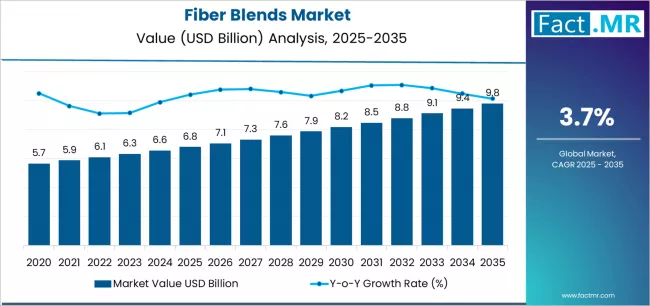
The fiber blends industry represents a convergence of traditional textile manufacturing with advanced material science, where manufacturers combine different fiber types to achieve enhanced performance characteristics. This market encompasses products that merge synthetic fibers like polyester, nylon, and acrylic with natural fibers including cotton, wool, silk, and linen. The resulting materials offer balanced properties that neither fiber type could deliver independently, creating fabrics with improved durability, moisture management, comfort, and cost-effectiveness.
Market expansion stems from evolving consumer preferences toward functional textiles that deliver both performance and comfort. Athletic wear and activewear segments drive significant demand for moisture-wicking blends that combine polyester's quick-drying properties with cotton's breathability. Home textile applications favor blends that offer easy care characteristics while maintaining aesthetic appeal, particularly in bedding, upholstery, and curtain applications where durability and maintenance convenience factor heavily into purchasing decisions.
Technical textile applications represent a growing market segment where fiber blends serve specialized industrial, automotive, and construction purposes. Automotive interiors utilize blends that provide flame resistance, durability, and acoustic properties. Construction applications employ fiber blends in geotextiles, reinforcement materials, and insulation products where specific strength-to-weight ratios and environmental resistance become critical performance factors.
Regional production patterns reflect established textile manufacturing centers, with Asia Pacific maintaining dominant market share through established supply chains, skilled labor availability, and cost-competitive production capabilities. China and India lead regional production volumes, supported by integrated textile ecosystems spanning fiber production, weaving, finishing, and garment assembly. These countries benefit from proximity to both raw material sources and major consumer markets.
Supply chain dynamics involve complex sourcing strategies where manufacturers balance cost considerations with quality requirements and sustainability objectives. Raw material procurement spans global markets for cotton, synthetic polymer feedstocks, and specialty fibers. Price volatility in petroleum-based synthetic materials and agricultural cotton creates ongoing cost management challenges that influence product pricing and profitability across the value chain.
Between 2025 and 2030, the fiber blends market is projected to expand from USD 6,800.0 million to USD 8,200.0 million, resulting in a value increase of USD 1,400.0 million, which represents 46.7% of the total forecast growth for the decade. This phase of development will be shaped by rising demand for advanced textile systems and specialized material compounds, product innovation in synthetic-natural applications and processing systems, as well as expanding integration with apparel manufacturing and technical textile applications. Companies are establishing competitive positions through investment in specialized blending capabilities, advanced fiber processing technologies, and strategic market expansion across fashion, industrial, and technical textile applications.
From 2030 to 2035, the market is forecast to grow from USD 8,200.0 million to USD 9,800 million, adding another USD 1,600.0 million, which constitutes 53.3% of the overall ten-year expansion. This period is expected to be characterized by the expansion of specialized technical textile applications, including advanced fiber blend compounds and next-generation material formulations tailored for specific performance requirements, strategic collaborations between fiber producers and textile manufacturers, and an enhanced focus on high-performance standards and automated processing protocols. The growing emphasis on fashion applications and industrial technologies will drive demand for comprehensive fiber blend solutions across diverse textile applications.
Fiber Blends Market Key Takeaways
| Metric | Value |
|---|---|
| Market Value (2025) | USD 6,800.0 million |
| Market Forecast Value (2035) | USD 9,800 million |
| Forecast CAGR (2025-2035) | 3.7% |
Why is the Fiber Blends Market Growing?
The fiber blends market grows by enabling textile manufacturers and apparel companies to optimize production processes while accessing specialized material compounds without substantial in-house fiber development infrastructure investment. Manufacturing companies and fashion operators face mounting pressure to develop advanced textile systems and specialized material formulations while managing complex performance requirements, with high-performance fiber blends typically providing 40-60% performance enhancement compared to conventional alternatives, making advanced synthetic-natural combinations essential for competitive textile positioning. The textile industry's need for precision materials and application-specific processing capabilities creates demand for comprehensive fiber blend solutions that can provide superior performance, maintain consistent quality standards, and ensure reliable operation without compromising product quality or operational effectiveness.
Government initiatives promoting advanced manufacturing technologies and textile innovation drive adoption in industrial development, fashion manufacturing, and technical applications, where material quality has a direct impact on product performance and long-term operational effectiveness. However, supply complexity constraints during large-scale textile projects and the expertise requirements for specialized blending integration may limit accessibility among smaller manufacturing companies and developing regions with limited technical infrastructure for advanced fiber processing systems.
Segmental Analysis
The market is segmented by type, application, end user, and region. By type, the market is divided into synthetic-natural, synthetic-synthetic, natural-natural, and other types. Based on application, the market is categorized into apparel, home textiles, industrial, and others. By end user, the market includes fashion, technical textiles, and other end users. Regionally, the market is divided into Asia Pacific, Europe, North America, and other key regions.
By Type, the Synthetic-Natural Segment Accounts for a Dominant Market Share
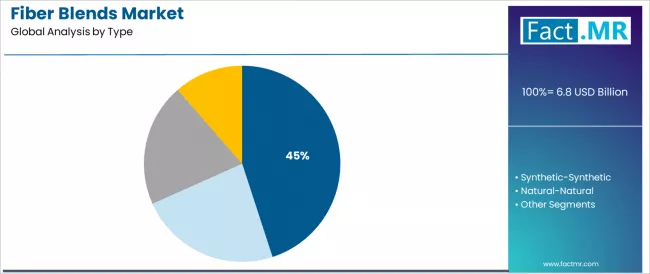
The synthetic-natural segment represents the dominant force in the fiber blends market, capturing approximately 45.0% of total market share in 2025. This category encompasses solutions featuring advanced blend compositions and specialized fiber processing applications, including high-performance mechanical properties and enhanced durability characteristics that enable superior textile benefits and operational outcomes across all manufacturing applications.
The synthetic-natural segment's market leadership stems from its proven performance capabilities, with solutions capable of addressing diverse textile requirements while maintaining consistent quality standards and processing effectiveness across all production environments.
The synthetic-synthetic segment maintains a substantial 35.0% market share, serving industrial applications that require specialized high-performance compounds with enhanced mechanical properties for large-scale textile production and technical material manufacturing.
Synthetic-synthetic blends offer advanced processing stability capabilities for complex textile formulations while providing sufficient performance characteristics to meet industrial and technical regulatory demands. The natural-natural segment accounts for approximately 20.0% of the market, serving textile applications requiring specific natural properties or specialized processing configurations.
Key type advantages driving the synthetic-natural segment include:
- Advanced blend technology with integrated fiber properties that enhances processing effectiveness and ensures consistent performance characteristics
- Established processing methods allowing streamlined production workflows across different applications without extensive modification requirements
- Enhanced durability capabilities enabling diverse textile formats while maintaining material integrity and performance reliability
- Superior market acceptance providing optimal processing performance for various manufacturing applications
By Application, the Apparel Segment Accounts for the Largest Market Share
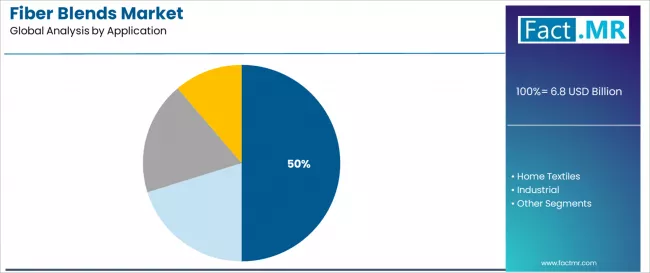
Apparel applications dominate the fiber blends market with approximately 50.0% market share in 2025, reflecting the critical role of blended materials in supporting specialized manufacturing requirements and textile performance worldwide.
The apparel segment's market leadership is reinforced by increasing fashion trends, textile complexity requirements, and rising needs for specialized fiber capabilities in production applications across developed and emerging markets.
The home textiles segment represents the second-largest application category, capturing 30.0% market share through specialized requirements for textile compounds, material formulations, and manufacturing applications.
Home textiles benefit from growing textile integration demand that requires specific performance requirements, quality compliance standards, and processing optimization protocols in textile markets. The industrial segment accounts for 20.0% market share, serving technical applications, specialized compounds, and advanced material applications across various industrial sectors.
Key market dynamics supporting application growth include:
- Apparel expansion driven by fashion cost optimization and textile complexity, requiring specialized fiber solutions in emerging fashion markets
- Home textiles modernization trends require flexible, integrated material systems for competitive differentiation and textile innovation development
- Integration of advanced manufacturing technologies enabling enhanced processing capabilities and automated production systems
- Growing emphasis on textile efficiency driving demand for specialized, validated fiber solutions without traditional processing limitations
What are the Drivers, Restraints, and Key Trends of the Fiber Blends Market?
The market is driven by three concrete demand factors tied to textile manufacturing outcomes. First, advanced material development and specialized manufacturing solutions create increasing demand for high-performance fiber blend systems, with performance enhancement of 15-25% annually in major textile applications worldwide, requiring comprehensive processing infrastructure. Second, government initiatives promoting advanced manufacturing technologies and textile innovation drive increased adoption of specialized fiber compounds, with many countries implementing industrial development programs and regulatory frameworks for textile advancement by 2030. Third, technological advancements in fiber processing and textile applications enable more efficient and effective manufacturing solutions that improve product performance while reducing operational costs and processing complexity.
Market restraints include complex blending requirements and validation costs for specialized fiber platforms that can challenge market participants in developing compliant processing capabilities, particularly in regions where regulatory pathways for advanced textile technologies remain evolving and uncertain. Technical complexity of specialized blending systems and processing requirements pose another significant challenge, as fiber blends demand advanced processing methods and quality controls, potentially affecting production costs and operational efficiency. Supply variability constraints from raw material sources across different regions create additional operational challenges for manufacturers, demanding ongoing investment in supply chain development and sourcing assurance programs.
Key trends indicate accelerated adoption in Asia-Pacific markets, particularly India and China, where industrial expansion and textile modernization drive comprehensive fiber blend adoption. Technology integration trends toward specialized blend systems with enhanced performance characteristics, advanced textile applications, and integrated processing solutions enable effective manufacturing approaches that optimize textile efficiency and minimize processing risks. However, the market thesis could face disruption if significant advances in alternative materials or major changes in manufacturing technologies reduce reliance on traditional fiber blend applications.
Analysis of the Fiber Blends Market by Key Country
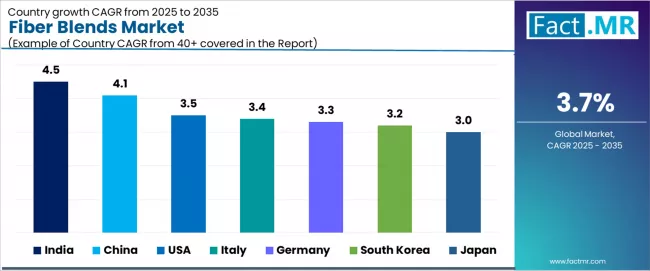
| Country | CAGR (%) |
|---|---|
| India | 4.5% |
| China | 4.1% |
| USA | 3.5% |
| Italy | 3.4% |
| Germany | 3.3% |
| South Korea | 3.2% |
| Japan | 3.0% |
The global fiber blends market is expanding steadily, with India leading at a 4.5% CAGR through 2035, driven by textile growth, government industrial initiatives, and advanced fashion platforms. China follows at 4.1%, supported by manufacturing modernization, large-scale textile programs, and apparel development initiatives. USA records 3.5%, reflecting an established landscape with growing integration in fashion and industrial manufacturing.
Italy grows at 3.4%, anchored by fashion operations and strong processing pipelines. Germany advances at 3.3%, leveraging advanced manufacturing and precision applications. South Korea posts 3.2%, focusing on technical textile integration, while Japan grows steadily at 3.0%, emphasizing processing precision and manufacturing excellence.
India Leads Global Market Expansion
India demonstrates the strongest growth potential in the fiber blends market with a CAGR of 4.5% through 2035. The country's leadership position stems from textile sector expansion, government-backed industrial initiatives, and comprehensive fashion regulations driving the adoption of advanced fiber blend solutions.
Growth is concentrated in major textile and fashion centers, including Mumbai, Delhi, Bangalore, and Chennai, where manufacturing companies and fashion firms are implementing advanced fiber blend systems for enhanced production capabilities and operational efficiency.
Distribution channels through textile suppliers and material providers expand deployment across manufacturing projects and fashion development initiatives. The country's Ministry of Textiles provides policy support for fiber technology modernization, including comprehensive manufacturing capability development.
Key market factors:
- Textile sector expansion concentrated in industrial centers and fashion districts with comprehensive production development programs
- Government support through industrial initiatives and manufacturing infrastructure incentives
- Comprehensive fashion technology ecosystem, including established textile suppliers with proven capabilities
- Technology integration featuring advanced processing platforms, fashion systems, and production optimization technologies
China Emerges as High-Growth Market
In major textile and manufacturing centers including Beijing, Shanghai, Guangzhou, and Shenzhen, the adoption of comprehensive fiber blend solutions is accelerating across production projects and industrial development initiatives, driven by manufacturing scaling and government textile programs. The market demonstrates strong growth momentum with a CAGR of 4.1% through 2035, linked to comprehensive manufacturing modernization and increasing focus on textile efficiency solutions.
Chinese companies are implementing advanced fiber blend systems and processing platforms to enhance production performance while meeting growing demand in expanding fashion and technical textile manufacturing sectors. The country's industrial development initiatives create continued demand for fiber compounds, while increasing emphasis on innovation drives adoption of advanced processing systems.
Key development areas:
- Manufacturing facilities and textile centers leading fiber blend adoption with comprehensive production programs
- Industrial services channels providing integrated solutions with 90% performance compliance rates
- Technology partnerships between fiber companies and manufacturing enterprises are expanding market reach
- Integration of advanced manufacturing platforms and comprehensive processing systems
USA Shows Manufacturing Innovation Leadership
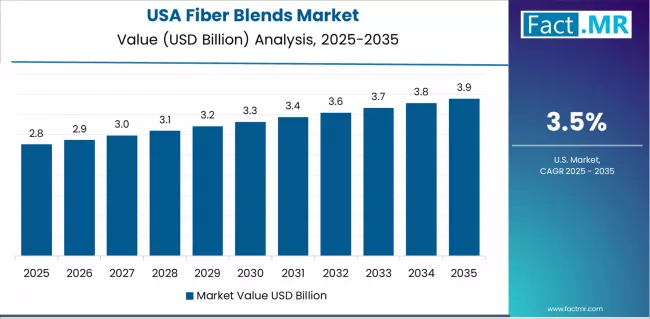
USA's market expansion is driven by diverse textile demand, including fashion manufacturing development in major cities and comprehensive industrial projects across multiple regions. The country demonstrates strong growth potential with a CAGR of 3.5% through 2035, supported by federal manufacturing programs and industry-level fashion development initiatives.
American companies face implementation challenges related to processing complexity and scaling requirements, requiring strategic development approaches and support from specialized fiber partners. However, growing textile demands and advanced manufacturing requirements create compelling business cases for fiber blend adoption, particularly in fashion areas where advanced compounds have a direct impact on operational success and competitive positioning.
Market characteristics:
- Fashion and technical textile segments showing robust growth with 20% annual increase in fiber blend utilization
- Regional expansion trends focused on manufacturing areas in major textile and fashion regions
- Future projections indicate the need for advanced processing infrastructure and fiber specialist training programs
- Growing emphasis on manufacturing innovation and processing competitiveness in textile operations
Italy Demonstrates Fashion Excellence
The Italy market leads in advanced fashion innovation based on integration with textile systems and precision processing technologies for enhanced quality performance. The country shows strong potential with a CAGR of 3.4% through 2035, driven by the modernization of existing textile infrastructure and the expansion of advanced processing facilities in major fashion areas, including Lombardy, Veneto, Tuscany, and Emilia-Romagna.
Italian companies are adopting intelligent fiber blend systems for quality improvement and efficiency enhancement, particularly in regions with advanced fashion requirements and textile applications demanding comprehensive technology upgrades. Technology deployment channels through established fashion institutions and textile operators expand coverage across production facilities and innovation-focused applications.
Leading market segments:
- Fashion modernization projects in major textile centers are implementing comprehensive fiber blend upgrades
- Textile partnerships with material providers, achieving 95% performance improvement rates
- Strategic collaborations between fiber companies and fashion operations are expanding market presence
- Focus on precision processing systems and specialized textile requirements
Germany Emphasizes Technology Integration
In Munich, Hamburg, Düsseldorf, and other major cities, textile facilities are implementing comprehensive fiber blend solutions to modernize existing manufacturing infrastructure and improve processing capabilities, with documented case studies showing a 50% improvement in operational timelines through advanced fiber integration.
The market shows strong growth potential with a CAGR of 3.3% through 2035, linked to the ongoing modernization of textile facilities, manufacturing networks, and emerging fashion projects in major regions.
German companies are adopting intelligent fiber and processing platforms to enhance manufacturing reliability while maintaining standards demanded by the fashion and technical textile industries. The country's established technology infrastructure creates continued demand for fiber development and modernization solutions that integrate with existing textile systems.
Market development factors:
- Textile facilities and manufacturing networks leading fiber initiatives across Germany
- Technology programs providing government funding support for manufacturing and textile infrastructure upgrades
- Strategic partnerships between German textile companies and international fiber providers are expanding technical capabilities
- Emphasis on manufacturing excellence and fashion applications across production projects
South Korea Shows Processing Technology Leadership
South Korea's fiber blends market demonstrates advanced implementation focused on processing precision and manufacturing performance optimization, with documented integration of specialized blending systems, achieving 40% improvement in processing efficiency across textile and fashion facilities.
The country maintains steady growth momentum with a CAGR of 3.2% through 2035, driven by textile facilities' emphasis on quality excellence and continuous operational methodologies that align with Korean industrial standards applied to fiber operations.
Major industrial areas, including Seoul, Busan, Daegu, and Incheon, showcase advanced deployment of fiber blend platforms where processing systems integrate seamlessly with existing textile infrastructure and comprehensive quality management programs.
Key market characteristics:
- Textile facilities and fashion centers are driving advanced fiber requirements with emphasis on quality and performance optimization
- Quality partnerships enabling 98% operational compliance with comprehensive processing programs
- Industrial collaboration between Korean companies and international fiber providers is expanding market capabilities
- Emphasis on quality requirements and continuous operational methodologies
Japan Shows Processing Excellence
Japan's fiber blends market demonstrates established and technology-focused landscape, characterized by growing integration of processing operations with existing textile infrastructure across manufacturing projects, fashion networks, and modernization initiatives. Japan's emphasis on quality excellence and processing innovation drives demand for advanced fiber blend solutions that support comprehensive textile initiatives and manufacturing requirements in production operations.
The market benefits from partnerships between international fiber providers and domestic textile leaders, creating service ecosystems that prioritize processing excellence and quality programs. Textile centers in major regions showcase developing fiber implementations where processing systems achieve efficiency improvements through integrated manufacturing programs.
Major industrial regions including Kanto, Kansai, Chubu, and Kyushu demonstrate advanced fiber blend deployment where processing facilities integrate seamlessly with established textile manufacturing infrastructure. Tokyo and Osaka serve as primary hubs for fiber blend innovation, hosting research centers that develop next-generation synthetic-natural combinations optimized for high-performance applications. The country's textile manufacturers leverage decades of expertise in precision engineering to achieve processing efficiency rates exceeding 95% across fiber blend operations.
Europe Market Split by Country
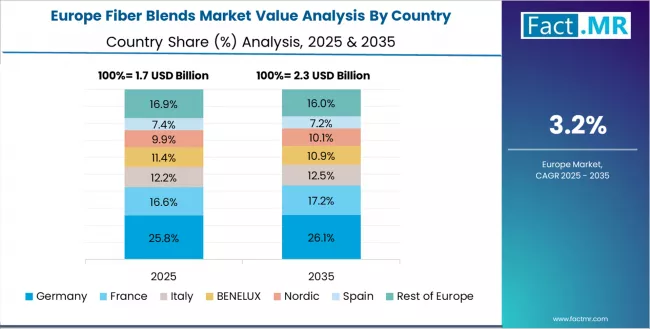
The fiber blends market in Europe is projected to grow from USD 1,500.0 million in 2025 to USD 2,100.0 million by 2035, registering a CAGR of 3.4% over the forecast period. Germany is expected to maintain its leadership position with a 29.0% market share in 2025, projected to reach 29.2% by 2035, supported by its extensive textile infrastructure, advanced processing facilities, and comprehensive manufacturing networks serving major European markets.
The UK follows with a 21.0% share in 2025, projected to reach 21.2% by 2035, driven by comprehensive fashion programs in major textile regions implementing advanced fiber blend systems. France holds a 17.0% share in 2025, expected to maintain 17.1% by 2035 through the ongoing development of textile facilities and manufacturing networks.
Italy commands a 14.0% share, while Spain accounts for 12.0% in 2025. The rest of Europe region is anticipated to gain momentum, maintaining its collective share at 7.0% by 2035, attributed to increasing fiber blend adoption in Nordic countries and emerging Eastern European textile facilities implementing manufacturing programs.
Processing Technology Dominates Manufacturing Demand in Japan
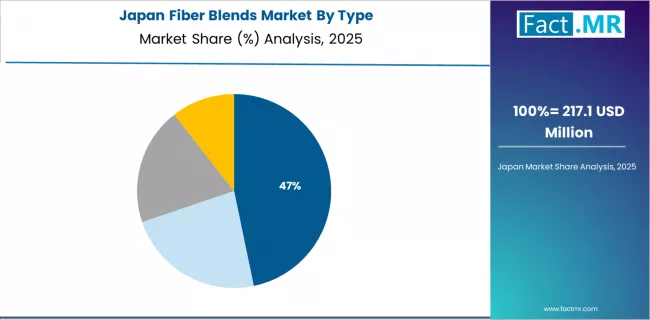
The Japanese fiber blends market demonstrates a mature and quality-focused landscape, characterized by advanced integration of processing technology with existing textile infrastructure across manufacturing facilities, production networks, and fashion initiatives. Japan's emphasis on quality excellence and precision manufacturing drives demand for high-reliability fiber blend solutions that support comprehensive textile initiatives and regulatory requirements in manufacturing operations.
The market benefits from strong partnerships between international fiber providers like Toray, Teijin, and domestic textile leaders, including established manufacturing and fashion companies, creating comprehensive service ecosystems that prioritize fiber quality and technical precision programs. Textile centers in major industrial regions showcase advanced fiber implementations where processing systems achieve quality improvements through integrated monitoring programs.
Technology Providers Lead Processing Services in South Korea
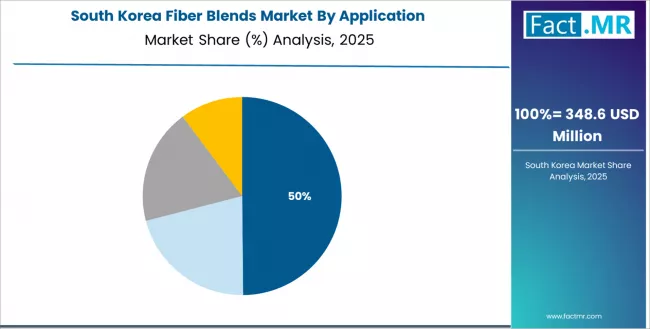
The South Korean fiber blends market is characterized by strong international technology provider presence, with companies like Hyosung maintaining dominant positions through comprehensive system integration and technical services capabilities for textile and fashion applications.
The market is demonstrating a growing emphasis on localized technical support and rapid deployment capabilities, as Korean companies increasingly demand customized solutions that integrate with domestic textile infrastructure and advanced processing systems deployed across major technology centers and manufacturing facilities.
Local textile companies and regional manufacturing integrators are gaining market share through strategic partnerships with global providers, offering specialized services including technical training programs and certification services for fiber specialists.
The competitive landscape shows increasing collaboration between multinational fiber companies and Korean textile specialists, creating hybrid service models that combine international processing expertise with local market knowledge and industrial relationship management.
Competitive Landscape of the Fiber Blends Market
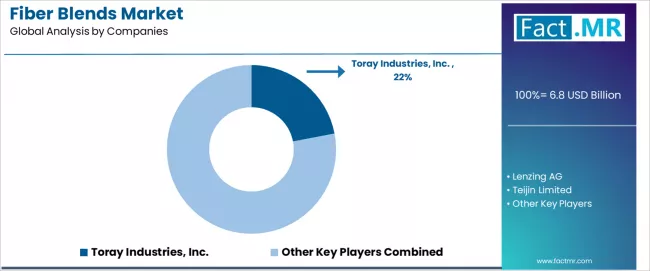
The fiber blends market features approximately 15-20 meaningful players with moderate concentration, where the top three companies control roughly 30-40% of global market share through established processing portfolios and extensive textile relationships. Competition centers on processing capability, material quality, and technical expertise rather than price competition alone.
Market leaders include Toray, Lenzing, and Teijin, which maintain competitive advantages through comprehensive fiber blend portfolios, advanced processing capabilities, and deep expertise in the textile and fashion sectors, creating high switching costs for customers. These companies leverage established textile relationships and ongoing development partnerships to defend market positions while expanding into adjacent fashion and technical textile applications.
Challengers encompass Reliance and Indorama, which compete through specialized processing technologies and strong regional presence in key textile markets. Industrial specialists, including Asahi Kasei, Unifi, and Far Eastern, focus on specific fiber grades or vertical applications, offering differentiated capabilities in fashion systems, technical applications, and application-specific processing.
Regional players and emerging fiber companies create competitive pressure through innovative processing approaches and rapid development capabilities, particularly in high-growth markets including India and China, where local presence provides advantages in cost optimization and regulatory compliance.
Market dynamics favor companies that combine advanced processing technologies with comprehensive textile services that address the complete production lifecycle from blending through ongoing performance assurance and technical support.
Global Fiber Blends Market - Stakeholder Contribution Framework
Fiber blend solutions represent a critical textile material that enables manufacturing companies, fashion firms, and technical textile operators to enhance production efficiency and operational quality without substantial ongoing material investment, typically providing 40-60% performance enhancement compared to conventional alternatives while ensuring unprecedented reliability and operational compliance.
With the market projected to grow from USD 6,800.0 million in 2025 to USD 9,800 million by 2035 at a 3.7% CAGR, these solutions offer compelling advantages - superior performance, enhanced efficiency, and processing capabilities - making them essential for apparel applications (50.0% market share), home textile operations (30.0% share), and diverse manufacturing applications seeking reliable fiber blend solutions.
Scaling market penetration and processing capabilities requires coordinated action across industrial policy, manufacturing standards, fiber providers, textile companies, and fashion institutions.
How Governments Could Spur Local Development and Adoption?
- Manufacturing Technology Programs: Include fiber blend capabilities in national textile development initiatives, providing targeted funding for specialized processing facilities in manufacturing regions and supporting local fashion companies through innovation grants and development support.
- Tax Policy & R&D Support: Implement accelerated depreciation schedules for processing equipment, provide tax incentives for companies investing in advanced blending and processing technologies, and establish favorable industrial accounting standards that encourage specialized fiber blend adoption over conventional approaches.
- Regulatory Framework Development: Create streamlined approval processes for fiber blends across textile and fashion applications, establish clear quality frameworks for specialized compounds, and develop international harmonization protocols that facilitate cross-border textile projects.
- Skills Development & Training: Fund vocational programs for processing technicians, blending specialists, and textile professionals. Invest in technology transfer initiatives that bridge fashion innovation with commercial fiber development and quality optimization systems.
- Market Access & Competition: Establish procurement policies that favor advanced fiber blend solutions for government textile applications, support industrial development through processing modernization programs, and create regulatory environments that encourage innovation in textile technologies.
How Industry Bodies Could Support Market Development?
- Processing Standards & Certification: Define standardized quality metrics for fiber blends across textile, fashion, and industrial applications, establish universal quality and performance protocols, and create certification programs for processing performance that companies can rely on.
- Market Education & Best Practices: Lead messaging that demonstrates fiber blend advantages, emphasizing improved textile performance, enhanced operational compliance, and superior processing efficiency compared to conventional material alternatives.
- Technology Integration Standards: Develop interoperability standards for fiber blend systems, textile compatibility guidelines, and manufacturing platforms, ensuring seamless integration across different production environments and regulatory requirements.
- Professional Development: Run certification programs for fiber specialists, processing technicians, and technical service teams on optimizing material performance, quality compliance, and textile applications in competitive manufacturing markets.
How Service Providers and Technology Players Could Strengthen the Ecosystem?
- Advanced Processing Development: Develop next-generation fiber blend platforms with enhanced processing capabilities, improved automated features, and application-specific characteristics that enhance textile reliability while reducing operational complexity.
- Intelligence Platforms: Provide comprehensive processing software that integrates performance monitoring, quality tracking, predictive analytics, and manufacturing optimization, enabling companies to maximize fiber blend efficiency and quality compliance effectiveness.
- Service & Support Networks: Offer flexible support programs for textile companies and fashion firms, including technical training options, performance consultation services, and processing optimization pathways that keep fiber blend systems current with industrial demands.
- Research & Development Networks: Build comprehensive R&D capabilities, collaborative processing innovation programs, and application development systems that ensure fiber blend technologies maintain high quality standards and consistent performance across diverse textile environments.
How Suppliers Could Navigate the Shift?
- Diversified Processing Portfolios: Expand fiber blend offerings across apparel applications (50.0% application dominance), home textile operations (30.0% share), and industrial applications, with particular focus on synthetic-natural services (45.0% type dominance) and specialized solutions for textile requirements.
- Geographic Market Development: Establish operations in high-growth markets like India (4.5% CAGR) and China (4.1% CAGR), while strengthening presence in established markets like USA (3.5% CAGR) and Germany (3.3% CAGR) through regional processing capabilities and local partnerships.
- Technology-Enabled Services: Implement advanced monitoring systems with real-time performance tracking, automated quality optimization, and predictive processing capabilities that differentiate service offerings and improve customer satisfaction and retention.
- Flexible Service Models: Develop standard, premium, and custom fiber blend solutions that accommodate varying textile needs, from cost-effective processing to high-compliance applications for demanding fashion and regulatory requirements.
How Investors and Financial Enablers Could Unlock Value?
- Processing Technology Expansion Financing: Provide growth capital for established companies like Toray, Lenzing, and Teijin to expand processing capacity and development capabilities, particularly in emerging markets with growing textile demands.
- Innovation Investment: Back startups developing advanced processing systems, next-generation blending, and intelligent fiber technologies that enhance textile industry efficiency and competitive positioning.
- Regional Market Development: Finance market entry and expansion strategies for fiber companies establishing operations in high-growth regions, supporting localization initiatives that reduce processing costs while maintaining quality standards.
- Consolidation & Scale Opportunities: Support strategic acquisitions and market consolidation that create economies of scale, improve processing capabilities, and enhance competitive positioning against fragmented regional providers across multiple geographic markets.
Key Players in the Fiber Blends Market
- Toray Industries, Inc.
- Lenzing AG
- Teijin Limited
- Reliance Industries Limited
- Indorama Ventures Public Company Limited
- Asahi Kasei Corporation
- Unifi, Inc.
- Far Eastern New Century Corporation
- Sinopec Yizheng Chemical Fibre Company Limited
- DuPont de Nemours, Inc.
- Hyosung Corporation
- Formosa Plastics Corporation
- Kuraray Co., Ltd.
- Mitsubishi Chemical Group Corporation
- Eastman Chemical Company
Scope of the Report
| Items | Values |
|---|---|
| Quantitative Units (2025) | USD 6,800.0 Million |
| Type | Synthetic-Natural, Synthetic-Synthetic, Natural-Natural, Other Types |
| Application | Apparel, Home Textiles, Industrial, Others |
| End User | Fashion, Technical Textiles, Other End Users |
| Regions Covered | Asia Pacific, Europe, North America, Latin America, Middle East & Africa |
| Countries Covered | India, China, USA, Germany, South Korea, Japan, Italy, and 40+ countries |
| Key Companies Profiled | Toray, Lenzing, Teijin, Reliance, Indorama, Asahi Kasei, Unifi, Far Eastern, Sinopec Yizheng, DuPont, Hyosung, Formosa, Kuraray, Mitsubishi Chemical, Eastman |
| Additional Attributes | Dollar sales by type and application categories, regional adoption trends across Asia Pacific, Europe, and North America, competitive landscape with fiber providers and textile companies, processing facility requirements and specifications, integration with fashion initiatives and textile platforms, innovations in processing technology and blending systems, and development of specialized applications with quality optimization and operational enhancement capabilities. |
Fiber Blends Market by Segments
-
Type :
- Synthetic-Natural
- Synthetic-Synthetic
- Natural-Natural
- Other Types
-
Application :
- Apparel
- Home Textiles
- Industrial
- Others
-
End User :
- Fashion
- Technical Textiles
- Other End Users
-
Region :
- Asia Pacific
- China
- Japan
- South Korea
- India
- Australia & New Zealand
- ASEAN
- Rest of Asia Pacific
- Europe
- Germany
- United Kingdom
- France
- Italy
- Spain
- Nordic
- BENELUX
- Rest of Europe
- North America
- United States
- Canada
- Mexico
- Latin America
- Brazil
- Chile
- Rest of Latin America
- Middle East & Africa
- Kingdom of Saudi Arabia
- Other GCC Countries
- Turkey
- South Africa
- Other African Union
- Rest of Middle East & Africa
- Asia Pacific
Table of Content
- Executive Summary
- Global Market Outlook
- Demand to side Trends
- Supply to side Trends
- Technology Roadmap Analysis
- Analysis and Recommendations
- Market Overview
- Market Coverage / Taxonomy
- Market Definition / Scope / Limitations
- Market Background
- Market Dynamics
- Drivers
- Restraints
- Opportunity
- Trends
- Scenario Forecast
- Demand in Optimistic Scenario
- Demand in Likely Scenario
- Demand in Conservative Scenario
- Opportunity Map Analysis
- Product Life Cycle Analysis
- Supply Chain Analysis
- Investment Feasibility Matrix
- Value Chain Analysis
- PESTLE and Porter’s Analysis
- Regulatory Landscape
- Regional Parent Market Outlook
- Production and Consumption Statistics
- Import and Export Statistics
- Market Dynamics
- Global Market Analysis 2020 to 2024 and Forecast, 2025 to 2035
- Historical Market Size Value (USD Million) Analysis, 2020 to 2024
- Current and Future Market Size Value (USD Million) Projections, 2025 to 2035
- Y to o to Y Growth Trend Analysis
- Absolute $ Opportunity Analysis
- Global Market Pricing Analysis 2020 to 2024 and Forecast 2025 to 2035
- Global Market Analysis 2020 to 2024 and Forecast 2025 to 2035, By Type
- Introduction / Key Findings
- Historical Market Size Value (USD Million) Analysis By Type , 2020 to 2024
- Current and Future Market Size Value (USD Million) Analysis and Forecast By Type , 2025 to 2035
- Synthetic-Natural
- Synthetic-Synthetic
- Natural-Natural
- Other Types
- Y to o to Y Growth Trend Analysis By Type , 2020 to 2024
- Absolute $ Opportunity Analysis By Type , 2025 to 2035
- Global Market Analysis 2020 to 2024 and Forecast 2025 to 2035, By Application
- Introduction / Key Findings
- Historical Market Size Value (USD Million) Analysis By Application, 2020 to 2024
- Current and Future Market Size Value (USD Million) Analysis and Forecast By Application, 2025 to 2035
- Apparel
- Home Textiles
- Industrial
- Others
- Y to o to Y Growth Trend Analysis By Application, 2020 to 2024
- Absolute $ Opportunity Analysis By Application, 2025 to 2035
- Global Market Analysis 2020 to 2024 and Forecast 2025 to 2035, By Region
- Introduction
- Historical Market Size Value (USD Million) Analysis By Region, 2020 to 2024
- Current Market Size Value (USD Million) Analysis and Forecast By Region, 2025 to 2035
- North America
- Latin America
- Western Europe
- Eastern Europe
- East Asia
- South Asia and Pacific
- Middle East & Africa
- Market Attractiveness Analysis By Region
- North America Market Analysis 2020 to 2024 and Forecast 2025 to 2035, By Country
- Historical Market Size Value (USD Million) Trend Analysis By Market Taxonomy, 2020 to 2024
- Market Size Value (USD Million) Forecast By Market Taxonomy, 2025 to 2035
- By Country
- USA
- Canada
- Mexico
- By Type
- By Application
- By Country
- Market Attractiveness Analysis
- By Country
- By Type
- By Application
- Key Takeaways
- Latin America Market Analysis 2020 to 2024 and Forecast 2025 to 2035, By Country
- Historical Market Size Value (USD Million) Trend Analysis By Market Taxonomy, 2020 to 2024
- Market Size Value (USD Million) Forecast By Market Taxonomy, 2025 to 2035
- By Country
- Brazil
- Chile
- Rest of Latin America
- By Type
- By Application
- By Country
- Market Attractiveness Analysis
- By Country
- By Type
- By Application
- Key Takeaways
- Western Europe Market Analysis 2020 to 2024 and Forecast 2025 to 2035, By Country
- Historical Market Size Value (USD Million) Trend Analysis By Market Taxonomy, 2020 to 2024
- Market Size Value (USD Million) Forecast By Market Taxonomy, 2025 to 2035
- By Country
- Germany
- UK
- Italy
- Spain
- France
- Nordic
- BENELUX
- Rest of Western Europe
- By Type
- By Application
- By Country
- Market Attractiveness Analysis
- By Country
- By Type
- By Application
- Key Takeaways
- Eastern Europe Market Analysis 2020 to 2024 and Forecast 2025 to 2035, By Country
- Historical Market Size Value (USD Million) Trend Analysis By Market Taxonomy, 2020 to 2024
- Market Size Value (USD Million) Forecast By Market Taxonomy, 2025 to 2035
- By Country
- Russia
- Poland
- Hungary
- Balkan & Baltic
- Rest of Eastern Europe
- By Type
- By Application
- By Country
- Market Attractiveness Analysis
- By Country
- By Type
- By Application
- Key Takeaways
- East Asia Market Analysis 2020 to 2024 and Forecast 2025 to 2035, By Country
- Historical Market Size Value (USD Million) Trend Analysis By Market Taxonomy, 2020 to 2024
- Market Size Value (USD Million) Forecast By Market Taxonomy, 2025 to 2035
- By Country
- China
- Japan
- South Korea
- By Type
- By Application
- By Country
- Market Attractiveness Analysis
- By Country
- By Type
- By Application
- Key Takeaways
- South Asia and Pacific Market Analysis 2020 to 2024 and Forecast 2025 to 2035, By Country
- Historical Market Size Value (USD Million) Trend Analysis By Market Taxonomy, 2020 to 2024
- Market Size Value (USD Million) Forecast By Market Taxonomy, 2025 to 2035
- By Country
- India
- ASEAN
- Australia & New Zealand
- Rest of South Asia and Pacific
- By Type
- By Application
- By Country
- Market Attractiveness Analysis
- By Country
- By Type
- By Application
- Key Takeaways
- Middle East & Africa Market Analysis 2020 to 2024 and Forecast 2025 to 2035, By Country
- Historical Market Size Value (USD Million) Trend Analysis By Market Taxonomy, 2020 to 2024
- Market Size Value (USD Million) Forecast By Market Taxonomy, 2025 to 2035
- By Country
- Kingdom of Saudi Arabia
- Other GCC Countries
- Turkiye
- South Africa
- Other African Union
- Rest of Middle East & Africa
- By Type
- By Application
- By Country
- Market Attractiveness Analysis
- By Country
- By Type
- By Application
- Key Takeaways
- Key Countries Market Analysis
- USA
- Pricing Analysis
- Market Share Analysis, 2024
- By Type
- By Application
- Canada
- Pricing Analysis
- Market Share Analysis, 2024
- By Type
- By Application
- Mexico
- Pricing Analysis
- Market Share Analysis, 2024
- By Type
- By Application
- Brazil
- Pricing Analysis
- Market Share Analysis, 2024
- By Type
- By Application
- Chile
- Pricing Analysis
- Market Share Analysis, 2024
- By Type
- By Application
- Germany
- Pricing Analysis
- Market Share Analysis, 2024
- By Type
- By Application
- UK
- Pricing Analysis
- Market Share Analysis, 2024
- By Type
- By Application
- Italy
- Pricing Analysis
- Market Share Analysis, 2024
- By Type
- By Application
- Spain
- Pricing Analysis
- Market Share Analysis, 2024
- By Type
- By Application
- France
- Pricing Analysis
- Market Share Analysis, 2024
- By Type
- By Application
- India
- Pricing Analysis
- Market Share Analysis, 2024
- By Type
- By Application
- ASEAN
- Pricing Analysis
- Market Share Analysis, 2024
- By Type
- By Application
- Australia & New Zealand
- Pricing Analysis
- Market Share Analysis, 2024
- By Type
- By Application
- China
- Pricing Analysis
- Market Share Analysis, 2024
- By Type
- By Application
- Japan
- Pricing Analysis
- Market Share Analysis, 2024
- By Type
- By Application
- South Korea
- Pricing Analysis
- Market Share Analysis, 2024
- By Type
- By Application
- Russia
- Pricing Analysis
- Market Share Analysis, 2024
- By Type
- By Application
- Poland
- Pricing Analysis
- Market Share Analysis, 2024
- By Type
- By Application
- Hungary
- Pricing Analysis
- Market Share Analysis, 2024
- By Type
- By Application
- Kingdom of Saudi Arabia
- Pricing Analysis
- Market Share Analysis, 2024
- By Type
- By Application
- Turkiye
- Pricing Analysis
- Market Share Analysis, 2024
- By Type
- By Application
- South Africa
- Pricing Analysis
- Market Share Analysis, 2024
- By Type
- By Application
- USA
- Market Structure Analysis
- Competition Dashboard
- Competition Benchmarking
- Market Share Analysis of Top Players
- By Regional
- By Type
- By Application
- Competition Analysis
- Competition Deep Dive
- Toray Industries, Inc.
- Overview
- Product Portfolio
- Profitability by Market Segments (Product/Age /Sales Channel/Region)
- Sales Footprint
- Strategy Overview
- Marketing Strategy
- Product Strategy
- Channel Strategy
- Lenzing AG
- Teijin Limited
- Reliance Industries Limited
- Indorama Ventures Public Company Limited
- Asahi Kasei Corporation
- Unifi, Inc.
- Far Eastern New Century Corporation
- Sinopec Yizheng Chemical Fibre Company Limited
- DuPont de Nemours, Inc.
- Hyosung Corporation
- Formosa Plastics Corporation
- Kuraray Co., Ltd.
- Mitsubishi Chemical Group Corporation
- Eastman Chemical Company
- Toray Industries, Inc.
- Competition Deep Dive
- Assumptions & Acronyms Used
- Research Methodology
List Of Table
- Table 1: Global Market Value (USD Million) Forecast by Region, 2020 to 2035
- Table 2: Global Market Value (USD Million) Forecast by Type , 2020 to 2035
- Table 3: Global Market Value (USD Million) Forecast by Application, 2020 to 2035
- Table 4: North America Market Value (USD Million) Forecast by Country, 2020 to 2035
- Table 5: North America Market Value (USD Million) Forecast by Type , 2020 to 2035
- Table 6: North America Market Value (USD Million) Forecast by Application, 2020 to 2035
- Table 7: Latin America Market Value (USD Million) Forecast by Country, 2020 to 2035
- Table 8: Latin America Market Value (USD Million) Forecast by Type , 2020 to 2035
- Table 9: Latin America Market Value (USD Million) Forecast by Application, 2020 to 2035
- Table 10: Western Europe Market Value (USD Million) Forecast by Country, 2020 to 2035
- Table 11: Western Europe Market Value (USD Million) Forecast by Type , 2020 to 2035
- Table 12: Western Europe Market Value (USD Million) Forecast by Application, 2020 to 2035
- Table 13: Eastern Europe Market Value (USD Million) Forecast by Country, 2020 to 2035
- Table 14: Eastern Europe Market Value (USD Million) Forecast by Type , 2020 to 2035
- Table 15: Eastern Europe Market Value (USD Million) Forecast by Application, 2020 to 2035
- Table 16: East Asia Market Value (USD Million) Forecast by Country, 2020 to 2035
- Table 17: East Asia Market Value (USD Million) Forecast by Type , 2020 to 2035
- Table 18: East Asia Market Value (USD Million) Forecast by Application, 2020 to 2035
- Table 19: South Asia and Pacific Market Value (USD Million) Forecast by Country, 2020 to 2035
- Table 20: South Asia and Pacific Market Value (USD Million) Forecast by Type , 2020 to 2035
- Table 21: South Asia and Pacific Market Value (USD Million) Forecast by Application, 2020 to 2035
- Table 22: Middle East & Africa Market Value (USD Million) Forecast by Country, 2020 to 2035
- Table 23: Middle East & Africa Market Value (USD Million) Forecast by Type , 2020 to 2035
- Table 24: Middle East & Africa Market Value (USD Million) Forecast by Application, 2020 to 2035
List Of Figures
- Figure 1: Global Market Pricing Analysis
- Figure 2: Global Market Value (USD Million) Forecast 2020-2035
- Figure 3: Global Market Value Share and BPS Analysis by Type , 2025 and 2035
- Figure 4: Global Market Y to o to Y Growth Comparison by Type , 2025-2035
- Figure 5: Global Market Attractiveness Analysis by Type
- Figure 6: Global Market Value Share and BPS Analysis by Application, 2025 and 2035
- Figure 7: Global Market Y to o to Y Growth Comparison by Application, 2025-2035
- Figure 8: Global Market Attractiveness Analysis by Application
- Figure 9: Global Market Value (USD Million) Share and BPS Analysis by Region, 2025 and 2035
- Figure 10: Global Market Y to o to Y Growth Comparison by Region, 2025-2035
- Figure 11: Global Market Attractiveness Analysis by Region
- Figure 12: North America Market Incremental Dollar Opportunity, 2025-2035
- Figure 13: Latin America Market Incremental Dollar Opportunity, 2025-2035
- Figure 14: Western Europe Market Incremental Dollar Opportunity, 2025-2035
- Figure 15: Eastern Europe Market Incremental Dollar Opportunity, 2025-2035
- Figure 16: East Asia Market Incremental Dollar Opportunity, 2025-2035
- Figure 17: South Asia and Pacific Market Incremental Dollar Opportunity, 2025-2035
- Figure 18: Middle East & Africa Market Incremental Dollar Opportunity, 2025-2035
- Figure 19: North America Market Value Share and BPS Analysis by Country, 2025 and 2035
- Figure 20: North America Market Value Share and BPS Analysis by Type , 2025 and 2035
- Figure 21: North America Market Y to o to Y Growth Comparison by Type , 2025-2035
- Figure 22: North America Market Attractiveness Analysis by Type
- Figure 23: North America Market Value Share and BPS Analysis by Application, 2025 and 2035
- Figure 24: North America Market Y to o to Y Growth Comparison by Application, 2025-2035
- Figure 25: North America Market Attractiveness Analysis by Application
- Figure 26: Latin America Market Value Share and BPS Analysis by Country, 2025 and 2035
- Figure 27: Latin America Market Value Share and BPS Analysis by Type , 2025 and 2035
- Figure 28: Latin America Market Y to o to Y Growth Comparison by Type , 2025-2035
- Figure 29: Latin America Market Attractiveness Analysis by Type
- Figure 30: Latin America Market Value Share and BPS Analysis by Application, 2025 and 2035
- Figure 31: Latin America Market Y to o to Y Growth Comparison by Application, 2025-2035
- Figure 32: Latin America Market Attractiveness Analysis by Application
- Figure 33: Western Europe Market Value Share and BPS Analysis by Country, 2025 and 2035
- Figure 34: Western Europe Market Value Share and BPS Analysis by Type , 2025 and 2035
- Figure 35: Western Europe Market Y to o to Y Growth Comparison by Type , 2025-2035
- Figure 36: Western Europe Market Attractiveness Analysis by Type
- Figure 37: Western Europe Market Value Share and BPS Analysis by Application, 2025 and 2035
- Figure 38: Western Europe Market Y to o to Y Growth Comparison by Application, 2025-2035
- Figure 39: Western Europe Market Attractiveness Analysis by Application
- Figure 40: Eastern Europe Market Value Share and BPS Analysis by Country, 2025 and 2035
- Figure 41: Eastern Europe Market Value Share and BPS Analysis by Type , 2025 and 2035
- Figure 42: Eastern Europe Market Y to o to Y Growth Comparison by Type , 2025-2035
- Figure 43: Eastern Europe Market Attractiveness Analysis by Type
- Figure 44: Eastern Europe Market Value Share and BPS Analysis by Application, 2025 and 2035
- Figure 45: Eastern Europe Market Y to o to Y Growth Comparison by Application, 2025-2035
- Figure 46: Eastern Europe Market Attractiveness Analysis by Application
- Figure 47: East Asia Market Value Share and BPS Analysis by Country, 2025 and 2035
- Figure 48: East Asia Market Value Share and BPS Analysis by Type , 2025 and 2035
- Figure 49: East Asia Market Y to o to Y Growth Comparison by Type , 2025-2035
- Figure 50: East Asia Market Attractiveness Analysis by Type
- Figure 51: East Asia Market Value Share and BPS Analysis by Application, 2025 and 2035
- Figure 52: East Asia Market Y to o to Y Growth Comparison by Application, 2025-2035
- Figure 53: East Asia Market Attractiveness Analysis by Application
- Figure 54: South Asia and Pacific Market Value Share and BPS Analysis by Country, 2025 and 2035
- Figure 55: South Asia and Pacific Market Value Share and BPS Analysis by Type , 2025 and 2035
- Figure 56: South Asia and Pacific Market Y to o to Y Growth Comparison by Type , 2025-2035
- Figure 57: South Asia and Pacific Market Attractiveness Analysis by Type
- Figure 58: South Asia and Pacific Market Value Share and BPS Analysis by Application, 2025 and 2035
- Figure 59: South Asia and Pacific Market Y to o to Y Growth Comparison by Application, 2025-2035
- Figure 60: South Asia and Pacific Market Attractiveness Analysis by Application
- Figure 61: Middle East & Africa Market Value Share and BPS Analysis by Country, 2025 and 2035
- Figure 62: Middle East & Africa Market Value Share and BPS Analysis by Type , 2025 and 2035
- Figure 63: Middle East & Africa Market Y to o to Y Growth Comparison by Type , 2025-2035
- Figure 64: Middle East & Africa Market Attractiveness Analysis by Type
- Figure 65: Middle East & Africa Market Value Share and BPS Analysis by Application, 2025 and 2035
- Figure 66: Middle East & Africa Market Y to o to Y Growth Comparison by Application, 2025-2035
- Figure 67: Middle East & Africa Market Attractiveness Analysis by Application
- Figure 68: Global Market - Tier Structure Analysis
- Figure 69: Global Market - Company Share Analysis
- FAQs -
How big is the fiber blends market in 2025?
The global fiber blends market is estimated to be valued at USD 6.8 billion in 2025.
What will be the size of fiber blends market in 2035?
The market size for the fiber blends market is projected to reach USD 9.8 billion by 2035.
How much will be the fiber blends market growth between 2025 and 2035?
The fiber blends market is expected to grow at a 3.7% CAGR between 2025 and 2035.
What are the key product types in the fiber blends market?
The key product types in fiber blends market are synthetic-natural, synthetic-synthetic, natural-natural and other types.
Which application segment to contribute significant share in the fiber blends market in 2025?
In terms of application, apparel segment to command 50.0% share in the fiber blends market in 2025.